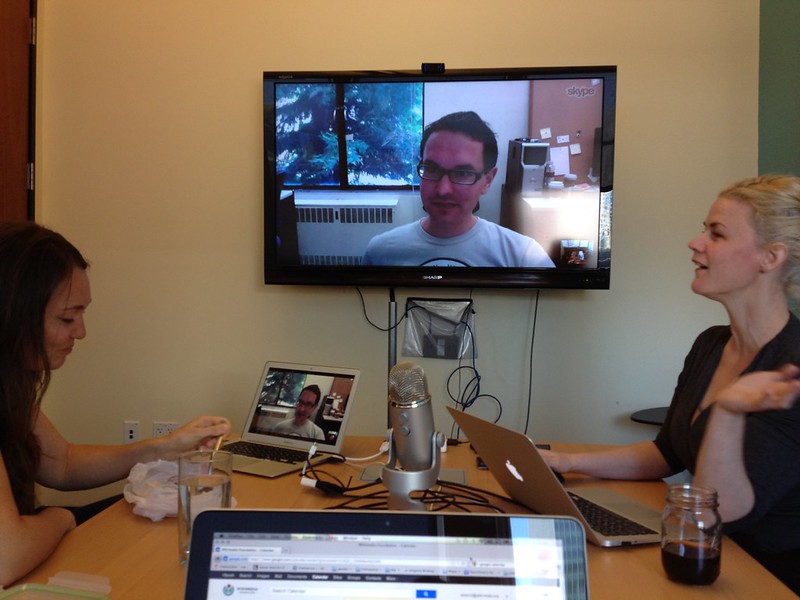The recent Future of Work conference, Reinventing the Workforce, hosted by Management Today, featured great speakers and engaging ideas. I’ve pulled out some of the most interesting and important themes and ideas from the presentations that can help you with implementing hybrid working and creating workplaces and workforces that meet the demands of the future. Here’s the first three, and there’ll be some more next time….
1. Your staff are humans first, employees second
One of the key learning points from the pandemic has been managers’ increased understanding of the specific circumstances of their staff, and an appreciation of them as individuals, suggested several speakers. Empathy and awareness has grown, whether from a video call seeing the inside of your colleagues’ homes with their dog walking into shot, supporting them through bereavement, the need to make adjustments so they can balance work and home-schooling or appreciating the physical/resource limitations that affected many (especially younger) staff.
“For a number of leaders [the pandemic] has reminded them of how ‘human’ their humans are”
…said Travis Ousley, Head of People at Distributed, who went on to comment that managers are now more aware that “a company is a collection of human beings… they’re not widgets.”
Engaging with their individual needs, ambitions and circumstances is essential, agreed Philip Eeles co-founder of Honest Burgers – “more businesses [should] see their humans as humans first rather than as employees.”
“Humans aren’t resources” is how Eeles summed up this sentiment, aligning his company with the growing number of organisations moving away from ‘Human Resources’ as a departmental name – in favour of ‘People Teams’ and similar.
There are scores of development interventions and working practices that rely on engaging deeply with the individual, their sense of purpose, their circumstances and desires. It appears reasonable to hope that the pre-existing shift to these more person-centric approaches may be boosted by managers’ increased empathy and understanding.
Ask yourself:
- Have you learned more about your team or your manager as individuals in the last year?
- How can you use this understanding to improve the way you work?
2. Be specific about how you ensure fairness
Remote and hybrid working is going to lead to different circumstances for workers, suggested multiple speakers, and managers need to be very specific about how we ensure fairness, said Michiel Verhoeven, Managing Director of SAP UK & Ireland.
 Like several contributors he considered the example of the hybrid meeting, with some people in the same room and some connected on a video screen. It’s an interesting case study to consider, because so many people (including me) have pre-pandemic experience of virtual attendees being second-class participants, struggling to hear, to make their point heard and rarely being directly consulted.
Like several contributors he considered the example of the hybrid meeting, with some people in the same room and some connected on a video screen. It’s an interesting case study to consider, because so many people (including me) have pre-pandemic experience of virtual attendees being second-class participants, struggling to hear, to make their point heard and rarely being directly consulted.
Verhoeven suggested solutions can be as simple as establishing clear ground rules at the start of meetings – consciously focusing on how all participants will include each other, whether in-office or virtually connected. He also floated the idea of continuing with virtual meetings, even if some people are in the same office and could meet in person, to maintain equality.
Beyond this instance of the hybrid meeting, there will be numerous challenges as people begin to work increasingly in different ways and settings. As Lorna Helps, founder of Vibrant Thinking, urges – it is up to organisations to ensure that ‘different’ does not mean ‘unfair.’
Challenge yourself:
- How will you ensure fairness between those in the office and those working remotely – on a practical and day-to-day level?
- What are the potential areas where individuals’ differing personal circumstances could lead to friction with their colleagues?
3. Solve the right problem
The challenges of a fair and effective return to the office are multi-dimensional and interconnected, and there is a danger, according to Stephen Scott, Divisional Growth Director at Capital People Solutions, that we develop solutions to the wrong problem.
He gave the example of people wanting to be in the office because it increased their exposure to senior management, and thus chances of recognition, allocation and ultimately promotion. I think we can all recognise the proximity bias that comes from working in the head office, or on the same floor as senior managers. Stephen Scott pointed out that trying to design a complicated hybrid working system which ensured everyone had equal access to the office/manager wasn’t the right approach – instead the organisation should acknowledge and tackle the proximity bias itself.
 Similarly, Lorna Helps of Vibrant Thinking referred to organisations trying to solve the question of ‘how do we cope if everyone wants to turn up in the office at the same time?’ The problem, she stated, was that organisations were starting from the wrong end by focusing on fine detail issues.
Similarly, Lorna Helps of Vibrant Thinking referred to organisations trying to solve the question of ‘how do we cope if everyone wants to turn up in the office at the same time?’ The problem, she stated, was that organisations were starting from the wrong end by focusing on fine detail issues.
Instead, they should start with Who questions and learn about their staff, then move onto What in terms of their roles and objectives and use this rich information about their workforce to make more relevant and effective responses to the final How questions.
An interesting point was raised by Katie Lloyd, Development Director at BBC News, in terms of how to get feedback to understand the important problems and issues. Her model of pulse surveys – short, 5 questions maximum, run frequently as a litmus test – sounded a lot more flexible, effective and suitable than a traditional big annual staff survey when looking to adapt and respond to internal or external change.
Consider:
- Are you tackling the problems not the symptoms? Try using root cause analysis tools such as 5 whys to get to the real heart of the problem
- Are you focusing on How before Who? Have you got too involved in the detail without understanding the needs, constraints and circumstances of the people affected?
- How do you hear staff opinions? Is there a place for short, sharp and high-frequency surveys?
4. Purpose underpins performance and ability to adapt.
In the face of the stresses and challenges of adapting to remote/hybrid working the message is to focus on an individual’s sense of purpose. Leena Nair, CHRO at Unilever, argued passionately that understanding and articulating an individual’s purpose was central to their autonomy and resilience – which supports their adaptation to new ways of working. If people can understand how change aligns with their purpose, she stated, then the change is no longer being ‘done to them.’
It was fascinating to hear how such a large company, no doubt seen by many as hard-edged, has embraced the concept of purpose – putting it as one of the four pillars of their individual development plans (along with energy, skills and leadership) and encouraging people to be upfront about their sense of purpose and share it with colleagues and managers.
The importance of intrinsic motivation and sense of purpose in driving meaningful success was foremost in Dr Cath Bishop’s presentation. The ‘meaningful’ is important here – an Olympic medalist herself, Dr Bishop shared the concept of ‘standing on the podium but feeling empty’ – and the difference between the short-term external rewards of ‘winning’ versus the success that gives fulfillment, lasting value and improves future performance. I’ve definitely added her book, The Long Win, to my reading list.
Think:
- How do you define success?
- Can you articulate your sense of purpose? Have you ever shared it with anyone?
- Could your team members articulate their purpose? – and if they can, do you know it?
- Could ‘purpose’ play a more important role in the development of yourself and others?
5. Let people find their own way
 Organisations should avoid over-engineering solutions for hybrid working problems, suggested Stephen Scott, Divisional Growth Director at Capital People Solutions. He pointed to those companies that have invested in solutions such as ‘digital water coolers’ as an attempt to recreate happenstance conversations for staff working remotely – and suggested that the company should take a step back, as people will always find their own way to communicate and socialise informally. Companies should be focusing on their fundamental strategy and purpose instead, he suggests as this is central to their relationship with their employees.
Organisations should avoid over-engineering solutions for hybrid working problems, suggested Stephen Scott, Divisional Growth Director at Capital People Solutions. He pointed to those companies that have invested in solutions such as ‘digital water coolers’ as an attempt to recreate happenstance conversations for staff working remotely – and suggested that the company should take a step back, as people will always find their own way to communicate and socialise informally. Companies should be focusing on their fundamental strategy and purpose instead, he suggests as this is central to their relationship with their employees.
Indeed, when developing hybrid working systems, make them as light-touch as possible, Lorna Helps of Vibrant Thinking argued, as it is the restrictions of over-complicated and inflexible frameworks that can lead to employees feeling not in control and experiencing stress.
Consider:
- How do you make sure that you’re sufficiently in control – but not too controlling?
- Could you take a step back? Are there areas and activities where it would be better to let the staff generate bottom-up, organic solutions and feel more in control?
6. Focus on your culture for long-lasting results
Paul Drucker may have declared ‘culture eats strategy for breakfast’ but in many organisations culture and values have been seen as less-important factors. However, that seems to be changing, stated Katie Lloyd, Development Director at BBC News, pointing to how the internal cultures of many organisations have been exposed for public comment and criticism. Issues such as discrimination, bias and toxic working conditions regularly appear in social and mainstream media alike, influencing consumers, stakeholders and potential employees. Katie Lloyd highlighted that organisations need meaningful engagement with their staff, including frequent highly-targeted surveys, to understand how their people really feel.
And the emphasis on culture should not be just about avoiding the negative. For Leena Nair, CHRO at Unilever, the most exciting development is the ability to translate the effects of ‘culture’ into metrics and indicators. She identifies that the high-engagement and value-driven culture of Unilever is instrumental in higher-than-expected retention levels and that the business benefits can now be tracked and calculated – e.g. in terms of reduced recruitment costs, effort and time.
The importance of identifying the organisational benefits of culture was echoed by Katie Lloyd, who proposed that the overall business objectives should be considered as the correct measure – ultimately culture impacts on everything the business does.
As Leena Nair argued, those of us who focus on culture should be excited. Through metrics we can show that culture is as important as strategy when it comes to business success. And it is social capital – a manifestation of culture – that will support us in adapting to new ways of working.
Challenge yourself:
- How much do you really know about your team or organisational culture?
- Is culture seen as important by senior management? By the staff?
- What are the measures you could use to evidence the importance of culture?
Reflection
It’s apparent that the pandemic has accelerated numerous pre-existing trends yet also forced many organisations into thinking about entirely new workforce approaches. One thing is clear – and it was mentioned on numerous occasions – don’t expect to get this right first time.
Everyone should be clear that implementing these new ways of working is an iterative process, and that compassion and understanding is needed as everyone needs to work together in the face of unprecedented change.
Book a free call to explore this further
If you want to talk through these ideas and challenges some more, then click here for a free 30 minute strategy call. I’ll help you decide what your next steps could be to support your team’s success.
Photos by Nathan Dumlao on Unsplash ; Sarah Stierch – CCBY2.0 – via Flickr ; Lex Photography on Pexels ; Florian Schmetz on Unsplash ; Alan Stanton – CC BY-SA 2.0 – via Flickr ; Fauxels on Pexels ; Nick Morrison on Unsplash
